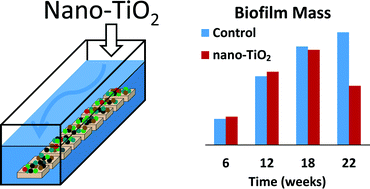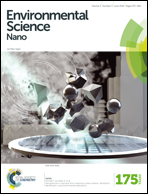Chronic addition of a common engineered nanomaterial alters biomass, activity and composition of stream biofilm communities
Abstract
Nano-TiO2 is an engineered nanomaterial that is found in a wide range of commercial products. Production of nano-TiO2 has increased rapidly over the last several decades, raising concerns about release of this material into the environment. Domestic wastewater is one route through which this material enters the environment, resulting in chronic inputs of low concentrations of nano-TiO2 to surface waters. The goal of this study was to assess impacts of chronic addition of an environmentally realistic concentration of nano-TiO2 on microbial biofilms, which play a foundational role in lotic ecosystems. Microbial consortia were collected from natural benthic habitats, cultivated in stream mesocosms, and exposed to daily additions of commercial nano-TiO2 pigment at a concentration that has been measured in treated wastewater effluent (30 μg L−1). After 22 weeks treated streams showed significantly lower amounts of biofilm (biofilm mass, bacterial and algal cell densities), lower biofilm metabolic activity (respiration and photosynthesis) and altered algal and bacterial community composition (the latter based on high-throughput sequencing of 16S rRNA genes) as compared to control streams. Specific changes in bacterial communities resulting from nano-TiO2 additions included increases in relative abundance of taxa linked to resistance to reactive oxygen species (Novosphingobium and Achromobacter) and decreases in relative abundance of taxa linked to nitrogen fixation (Pleurocapsa and Azoarcus) and denitrification (Paracoccus). These data provide one of the first demonstrations that low-level, chronic release of nano-TiO2 to streams can have significant, negative effects on structure and function of benthic communities and the critical ecosystem services they provide.


 Please wait while we load your content...
Please wait while we load your content...